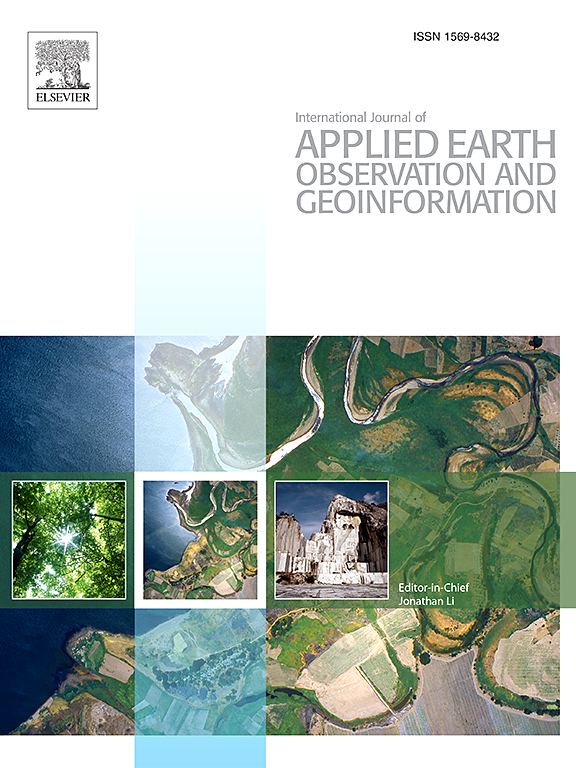人口分析单元的异构多尺度时空相互作用网络模型
IF 7.6
Q1 REMOTE SENSING
International journal of applied earth observation and geoinformation : ITC journal
Pub Date : 2025-05-14
DOI:10.1016/j.jag.2025.104565
引用次数: 0
摘要
人口分析单元(PAUs)作为容纳人口活动的基本空间单元,在构建时空相互作用网络、了解单元内人口分布和活动格局以及单元间相互作用等方面具有重要意义。然而,现有网络受固定尺度的限制,缺乏时间动态,对多尺度特征的考虑不足,从而限制了网络的语义表示和动态分析能力。为此,我们提出了一种集成空间、时间和语义表示的异构多尺度PAU交互网络(HMS-PAU-IN)模型,实现了基于时空知识图的HMS-PAU-IN建模和语义分析。在空间维度上,时空相互作用分为由人口流动驱动的显性相互作用和由空间关系塑造的潜在相互作用。在时间维度上,通过节点在不同时间窗之间的演化关系来捕捉PAUs的变化。为了验证该模型的有效性,我们建立了一个融合PAUs多尺度特征的种群预测模型,并引入了基于Leiden算法的leden - ies - pms社区检测方法,该方法集成了内外环境语义并采用邻近合并策略。实验结果表明,该模型和方法能够有效表征多尺度PAUs之间的时空相互作用,提高了社区尺度上人口分布预测的准确性(R2 = 0.77),提高了建筑尺度上时间群落分析的可解释性。本研究建立了一个多尺度时空框架,用于分析PAUs内的人口分布、活动模式和社区演变,为城市规划、资源优化和可持续管理提供可操作的见解。本文章由计算机程序翻译,如有差异,请以英文原文为准。
HMS-PAU-IN: A heterogeneous multi-scale spatiotemporal interaction network model for population analysis units
Population analysis units (PAUs), as fundamental spatial units accommodating population-related activities, hold significance in constructing spatiotemporal interaction networks to understand intra-unit population distribution and activity patterns as well as inter-unit interactions. However, existing networks are constrained by fixed scales and the absence of temporal dynamics, with insufficient consideration of multi-scale features, thereby limiting their semantic representation and dynamic analysis capabilities. Thus, we proposed a heterogeneous multi-scale PAU interaction network (HMS-PAU-IN) model that integrates spatial, temporal, and semantic representations, enabling HMS-PAU-IN modeling and semantic analysis based on spatiotemporal knowledge graph. In the spatial dimension, spatiotemporal interactions are classified into explicit interactions driven by population flows and potential interactions shaped by spatial relationships. In the temporal dimension, the changes of PAUs are captured through the evolutionary relationships of nodes between different time windows. To validate the model, we developed a population prediction model that integrates the multi-scale features of PAUs and introduced Leiden-IES-PMS, a community detection method based on the Leiden algorithm, which integrates internal and external environmental semantics and adopts a proximity merging strategy. Experimental results demonstrate that the proposed model and method effectively characterize spatiotemporal interactions among multi-scale PAUs, enhancing the accuracy of population distribution prediction (R2 = 0.77) at the community scale, and improving the interpretability of temporal community analysis at the building scale. This study develops a multi-scale spatiotemporal framework for analyzing population distribution, activity patterns, and community evolution within PAUs, providing actionable insights for urban planning, resource optimization, and sustainable management.
求助全文
通过发布文献求助,成功后即可免费获取论文全文。
去求助
来源期刊

International journal of applied earth observation and geoinformation : ITC journal
Global and Planetary Change, Management, Monitoring, Policy and Law, Earth-Surface Processes, Computers in Earth Sciences
CiteScore
12.00
自引率
0.00%
发文量
0
审稿时长
77 days
期刊介绍:
The International Journal of Applied Earth Observation and Geoinformation publishes original papers that utilize earth observation data for natural resource and environmental inventory and management. These data primarily originate from remote sensing platforms, including satellites and aircraft, supplemented by surface and subsurface measurements. Addressing natural resources such as forests, agricultural land, soils, and water, as well as environmental concerns like biodiversity, land degradation, and hazards, the journal explores conceptual and data-driven approaches. It covers geoinformation themes like capturing, databasing, visualization, interpretation, data quality, and spatial uncertainty.
 求助内容:
求助内容: 应助结果提醒方式:
应助结果提醒方式:


